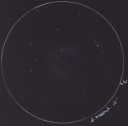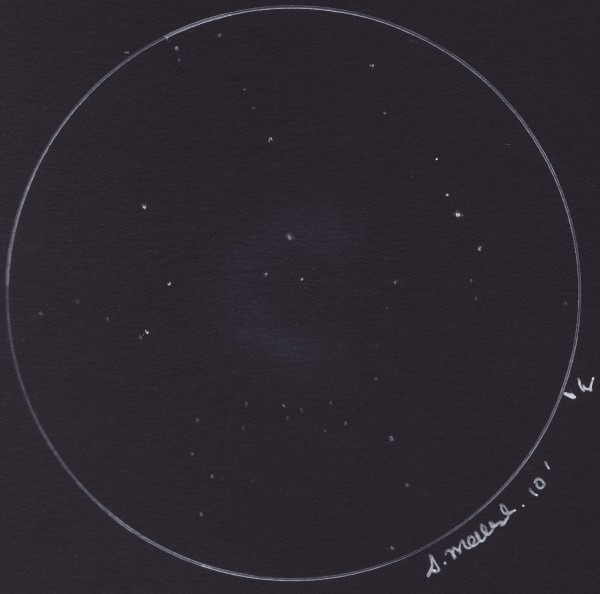Abell 21
PK 205+14.1
SH2-274
Planetary Nebula
Gemini
12/12/10
Ilford NSW Australia
56cm f5 dobsonian telescope
Field: 29′
Magnification: 166x with Oxy III filter
Sky quality meter reading: 21:55
Black Canford paper
White pastel chalk
White oil pencil
Soft white pencil
Paint brush
Blending stump
After three months of dismal wet new moon periods I finally scored two nights of decent conditions. My observing site was quite damp from all the rain and the days were humid, so this conspired to bring out a plague of mosquitoes of biblical proportions, hence I had to put on some repellent whilst out observing. The far northern constellation of Gemini was well placed so I decided to observe a few objects that I had listed. The so called “Medusa Nebula” was one of my first targets and it proved most interesting in the 56cm dob at 166x magnification. This diffuse nebula was visible without an Oxy III filter, but it improved slightly when the filter was inserted. Abell 21 was once thought to be a supernova remnant until Soviet astronomers in the 1970’s proved otherwise. It is a rather large planetary and visually shows no sign in the eyepiece of the braid like filamentary structure evident in images.
Scott Mellish


Scott,
Your sketch is very interesting. Thanks!
Marek 🙂
Scott,
Very nice work at your horizon. Mosquitoes can really break up your concentration. This target looks like it would be difficult even without the little biting dipterans.
Frank 🙂
Scott,
How faint is that!
Your technique is so well suited to objects this soft in appearance. Great stuff. I’m hoping to put this technique to practice this coming new Moon too. You’ve just gotta love the clouds, or go mad.
Mosquitoes! I’ve started seeing some around my place the size of tennis balls. Scary! And the sound they make is like drone of a Spitfire, and nearly as loud.
Thank you all.
Abell 21 probably would have been a bit better defined at slightly lower magnification and with a wider field.
So you would probably still see it in a 20cm scope under the right conditions.
Scott.